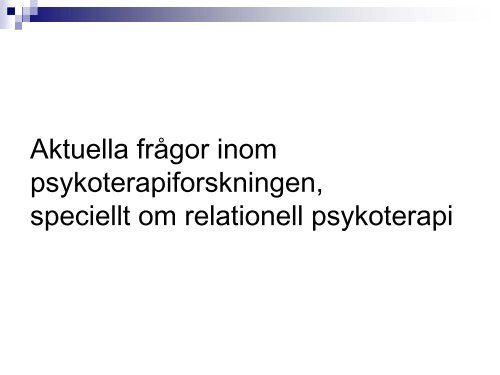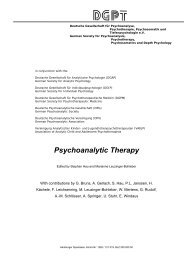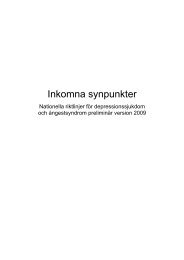Aktuella frågor inom psykoterapiforskningen, speciellt om relationell ...
Aktuella frågor inom psykoterapiforskningen, speciellt om relationell ...
Aktuella frågor inom psykoterapiforskningen, speciellt om relationell ...
Create successful ePaper yourself
Turn your PDF publications into a flip-book with our unique Google optimized e-Paper software.
<strong>Aktuella</strong> frågor <strong>in<strong>om</strong></strong><strong>psykoterapiforskningen</strong>,<strong>speciellt</strong> <strong>om</strong> <strong>relationell</strong> psykoterapi
Vilka frågor kan vara aktuella?• Psykiatriseringen av terapiforskningen (RCT, följsamhet,diagnoser, manualer)• Terapeutfaktorn och alliansen s<strong>om</strong> ständigtunderbeforskade• När vi nu (<strong>om</strong>igen) börjar förstå att för de flesta tillståndfinns det flera olika terapier s<strong>om</strong> har ungefär sammaeffekt, vad vill vi då veta?• Moderatorer? Mediatorvariabler?
Terapeutfaktorn
Huppert, J. D., Bufka, L. F., Barlow, D. F., Gorman, J. M., et al. (2001). Therapists,therapist variables, and cognitive-behavioral therapy outc<strong>om</strong>e in a multicenter trial forpanic disorder. Journal of Counseling and Clinical Psychology, 69, 747-755.
Följsamhet till manualen
Huppert, J. D., Barlow, D. H., Gorman, J. M., Shear, M. K. & Woods, S.W. (2006). The interaction of motivation and therapist adherencepredicts outc<strong>om</strong>e in cognitive behavioral therapy for panic disorder:Preliminary findings. Cognitive and Behavioral Practice, 13, 198–204
Alliansen och utfallet:Vilken k<strong>om</strong>mer först?
Zuroff, D. C. & Blatt, S. (2006). The therapeutic relationship in the brieftreatment of depression:Contributions to clinical improvement andenhanced adaptive capacities. Journal of Consulting and ClinicalPsychology, 74, 130-140• Data från NIMH TDCRP• Behandlingsmetoder:IPTCBTIMI-CMPLA-CM• 191 patienter, alla med MD• Utfallet mäts med en k<strong>om</strong>bination av BDI, HRSD, HSCL-90, GAFoch SAS
Resultat• Sambandet mellan relationskvalité och utfall kvarstod när man hadekontrollerat för utfallet vid alliansskattningstillfället• Sambandet gällde oberoende <strong>om</strong> man använde patientens självskattningeller bedömarskattningar för utfallet. Patientens egen skattning hade dockstarkast samband med utfallet.• Sambandet gällde både för utfall s<strong>om</strong> mättes under terapin, vid terapinsavslutning och 18 månader efter terapins avslutning.• Sambandet kunde inte förklaras av de patientkarakteristika man hade mättföre terapin (bl a kön, ålder, tillståndets längd, hur tidigt i livet det förstadepressionstillfället hade inträffat, ett antal personlighetsavvikelser)• Sambandet gällde alla de fyra behandlingsalternativen.
“Psychotherapy research and clinical training are atpresent preoccupied with evaluating and disseminatingmanualized packages of treatment techniques. Ourfindings underscore the importance of directing equalattention to research and training addressing thetherapeutic relationship. Students of psychotherapy needto acquire broad clinical skills such as listening attentively,encouraging emotional exploration, and supportingpatients’ auton<strong>om</strong>y at least as much as they need t<strong>om</strong>aster specific technical procedures. Furthermore, trainingin establishing effective relationships should not beconstrued as instruction in a discrete set of manualizabletechniques, but rather as learning to be sensitively attunedto each patient’s personality and responding to theirbehavior flexibly and appropriately“(s. 138-139).
Terapier där mentaliseringsförmåganundersöktsLevy, K. N., Meehan,K. B., Kelly, K. M., Reynoso, J. S., Weber, M., Clarkin,J. F. & Otto F. Kernberg, O. F. (2006).Change in attachment patterns and reflective function in a rand<strong>om</strong>izedcontrol trial of transference-focused psychotherapy for Borderlinepersonality disorder.Journal of Consulting and Clinical Psychology, 74, 1027-1040.
Rudden, M., Milrod, B., Target, M., Ackerman, S. & Graf, E. (2006).Reflective functioning in panic disorder patients. Journal of theAmerican Psychoanalytic Association, 54, 1339-1342.• Generell RF var inte lägre i den här gruppen patienter änför icke-kliniska individer (RF = 5.15)• Symt<strong>om</strong>specifik RF var lägre (PSRF= 4.43)• Ingen skillnad i PSRF före behandlingen mellan de tvågrupperna, men efter behandlingen ökade värdetsignifikant för PFPP (p = .02) och sjönk för TA (p = .002).Effektstorleken för denna förändring var d = .52 för PFPoch d = -.88 för TA.• Det fanns ingen korrelation mellan förändring i PSRF ochförändring av symt<strong>om</strong>
Terapier där <strong>relationell</strong>ainterventioner undersöktsHöglend, P., Bogwald, K.-P., Amlo, S., Marble,A., Ulberg, R., Sjaastad, M. C., Sorbye, O.,Heyerdahl, O. & Johansson, P. (2008).Transference interpretations in dynamicpsychotherapy: Do they really yield sustainedeffects?American Journal of Psychiatry, 165, 763-771.
Den <strong>relationell</strong>a psykoterapin
”The belief that s<strong>om</strong>ehow science will decide it all strikesme at this point as not terrible rational – actually, more likea faith! I find myself putting more faith in the utility ofpsychoanalytic ideas to help people experiencethemselves in a richer, freer way than in the effectivenessof empirical research to sort out the enormousc<strong>om</strong>plexities and mysteries of mind.” (Stephen Mitchell,2000, s. 159)
“Today we recognize the profound influence of the analyst’s subjectivity, and sorelational psychoanalysis must strive for a good fit between patient and analystwith no one prescribed technique. But how do we teach such a personalapproach? We no longer have recourse to a specific manual of psychoanalytictechnique. This is why it strikes so many of us as ludicrous to think that wecould ever properly manualize a psychoanalytic treatment. But if it is sopersonal, so subjective, so much based on what the analyst feels in reaction tothe patient, if each of the analyst’s interventions is so uniquely determined bywho they are as individuals and who they have bec<strong>om</strong>e with specific patients,then we have to rethink not only how psychoanalysis is conducted, but alsohow psychoanalysis is taught. The teaching too must bec<strong>om</strong>e moreintersubjective and interpersonal. It is not that I do not think we have much toteach, quite to the contrary, I think that we have an enormous amount to teach,but it does not take the form of prescribed rules but rather we teach studentanalysts how to think reflexively about their clinical decision making with eachspecific patient based on the unique two-person situation that evolves in theanalysis” (Aron, 2007, ss. 98-99).
Några studier från Beth Israel
Safran, J. D., Muran, J. C., Samstag, L. W. & Winston, A. (2005).Evaluating alliance-focused intervention for potential treatment failures:A feasibility study and descriptive analysis. Psychotherapy: Theory,Research, Practice, Training, 42, 512-531.• 60 patienter rand<strong>om</strong>iseras till två terapiformer: CBT ochSTDP• Efter 8 samtal bedömer man att 18 patienter (13 STDPoch 5 CBT) skulle kunna bli misslyckanden• De erbjuds att byta terapiform. Tio antar erbjudandet.• De lottas till antingen den alternativa terapiformen (2 + 3)eller till BRT (5)
Resultat• Av de 42 patienter s<strong>om</strong> inte erbjöds att välja en annan terapiform,avbröt 12 terapin i förtid (falska negativa)• Av de 8 patienter s<strong>om</strong> erbjöds att byta behandlingsform mentackade nej avbröt 7 behandlingen i förtid• Av de fem patienter s<strong>om</strong> antog erbjudandet att få byta behandlingoch s<strong>om</strong> lottades till den alternativa behandlingsformen avbröt allafem behandlingen i förtid• Av de fem s<strong>om</strong> lottades till BRT avbröt två behandlingen i förtid(varav en hade ett planerat avbrott i samband med en flyttning)
Muran, J. C., Safran, J. D., Samstag, L. W. & Winston, A. (2005). Evaluating analliance-focused treatment for personality disorders. Psychotherapy: Theory,Research, Practice, Training, 42, 532-545.• 128 patienter rand<strong>om</strong>iseras till CBT, STDPeller BRT• Huvudinklusionskriterium varPersonlighetsstörning Kluster C
• De tre terapiformerna var lika effektiva, räknatpå medelvärden• BRT och CBT var något bättre <strong>om</strong> man användeRCI och klinisk förbättring s<strong>om</strong> mått• BRT behöll patienterna bättre
Stevens, C. L., Muran, J. C., Safran, J. D., Gorman, B. S. & Winston A. (2007).Levels and Patterns of the Therapeutic Alliance in Brief Psychotherapy.American Journal of Psychotherapy, 61, 109-129.• Hypotesen var att tre förhållanden skullepredicera positivt utfall:1. Hög nivå på patientens alliansskattningar2. Ökande nivå (linjär trend)3. Rupture-repair• Den första hypotesen bekräftades, inte deandra
Betydelsen av terapeutensemotionella förhållningssättGrepmair, L., Mitterlehner, F., Loew, T., Bachler, E., Rother, W. & Nickel,M. (2007). Pr<strong>om</strong>oting mindfulness in psychotherapists in traininginfluences the treatment results of their patients: A rand<strong>om</strong>ized,double-blind, controlled study. Psychotherapy and Psychos<strong>om</strong>atics, 76,332-338.
Design• 124 inneliggande patienter får terapi i 9 veckor• Nio terapeuter övar mindfulness direkt företerapisamtalen, 9 andra övar vid andra tillfällen.• Patienterna är inte medvetna <strong>om</strong> attterapeuterna övar mindfulness, terapeuterna ärinte medvetna <strong>om</strong> att vissa gör det i anslutningtill terapitimmarna och andra inte
Vår studieIPT vs BRT för deprimerade patienter• Förhoppningsvis 104 terapier• Samma terapeuter utför båda terapierna• Depression enligt Hamilton primärt utfallsmått• Är Dependence eller Self-criticism moderatorer?• Är BRT bättre för SC-patienter?• Är RF, allians eller mindfulness mediatorer?
• Intervjuer (alla tre intervjuerna gen<strong>om</strong>förs före, efter och vid uppföljningen av terapin)• Structured Clinical Interview for DSM-IV – Axis I and II Disorders (SCID I och II; Firstet al., 1999) s<strong>om</strong> också ger möjlighet att skatta Hamilton Rating Scale for• Depression (HRSD; Hamilton, 1960)• Adult Attachment Interview (AAI; Main, Caplan & Cassidy, 1985), k<strong>om</strong>binerad medDSRF Interview (modifierad efter Rudden, 2007• Självrapportformulär• Före, efter och vid uppföljning samt efter vart fjärde samtal:• OQ-45 (Outc<strong>om</strong>e Questionnaire 45; Lambert et al., 2004)• Patient Health Questionnaire (PHQ-9; Spitzer, Kroenke & Williams, 1999)• Före, efter och vid uppföljning:• Inventory of Interpersonal Problems (IIP; Horowitz et al., 1988)• Quality of Life Inventory (QOLI; Frisch, Cornell, Villanueva, & Retzlaff, 1992 )• Depressive Experiences Questionnaire (DEQ; Blatt, D'Afflitti & Quinlan, 1976)• Five Facet Mindfulness Questionnaire (FFMQ; Baer, Smith, Hopkins, Krietemeyer &Toney, 2006)• Processmått (ifylls av både patient och terapeut efter varje samtal)• Working alliance Inventory, kort version (WAI; Horvath, 2001)• Känsloord (Holmqvist & Armelius, 1994)• Processmått (ifylls av terapeuten enbart, före terapins början)• Allegiance (eget formulär)• Terapeutisk identitet (ThId; Sandell, Broberg, Schubert, Grant & Lazar, 2007)
In all honesty, I expect few differences between any structured short-termtreatment, because non-specific factors and therapist factors are probablymost important, and little variance is explained by specific techniques. But Ithink it could be highly relevant to show that BRT is effective c<strong>om</strong>pared toan established treatment.I then think that you will find few if any differences on outc<strong>om</strong>e measures,all studies in this respect have c<strong>om</strong>e up with non-significant differences in“theory-specific” measures (eg dysfunctional attitudes for CBT andinterpersonal problems for IPT). The moderating approach seems muchmore fruitful, showing that patient factors within a rand<strong>om</strong>ized trial predictdifferential outc<strong>om</strong>e, and probably in both conditions. In addition, theprocess of change might be different for different patients and in thedifferent treatments. I would lay my eggs in that basket, not in thedifferences between treatments. Remember that even experts couldn’t tellthe difference between IPT and CBT on videotapes of highly experiencedand trained therapists!(Patrick Luyten, 2009, personligt meddelande)
Andra möjliga frågor:• Terapeutskillnader (de använder båda terapimetoderna)• Terapeutens allegiance• Vad betyder följsamhet till riktlinjer för utfallet?• Hur förhåller RF s<strong>om</strong> utfall sig till depressionsmåtten?• Hur är förhållandet mellan allians och utfall underterapins förlopp?





